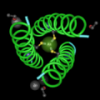The C.R.E.A.T.E. strategy is an approach to making biology teaching a better model of biology, the science.
From the C.R.E.A.T.E website,
...C.R.E.A.T.E. teaching focuses on on authentic published work--peer reviewed journal articles--with students reading either series of papers produced sequentially from individual labs or series of papers from different labs focused on a single line of research.
This summer and next, the National Science Foundation is funding two identical workshops designed to help instructors learn how to use the C.R.E.A.T.E. strategy.
These will be held in June 2012 and 2013 at Hobart College and William Smith College, in Geneva, New York. All expenses will be covered except for travel.
If you're interested, APPLY NOW The deadline is January 15, 2012.
You can download the pdf application form and more information from this page.
C.R.E.A.T.E. stands for:
Consider
Read
Elucidate the hypotheses
Analyze and interpret the data and
Think of the next
Experiment
The timing of the workshop announcement a little ironic, since New York congresswoman Carolyn Maloney is co-sponsoring a bill (HR3699 The Research Works Act (click the "Bill pdf" link at the site to download the bill) that will make it much more difficult for students to access this valuable resource.
